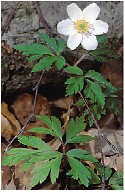

Wood Anemone (Anemone nemorosa) P
Folk Names: Hexenblum (German), Kopfschmerzblum (German) Smell Fox, Wind Flower, Wind Crowfoot, Wood Crowfoot
Description: The wood anemone has a long, tough, creeping wood-stock running just below the ground. It is the quick growth of this root system that causes the rapid spread of this plant, forming huge colonies in the moist soil of woods and thickets. Wood anemone is one of the earliest spring flowers. Like other anemones, wood anemone has a three lobed leaf just below each flower. These leaves are often so divided that it appears to have more than three leaflets. This leaf wraps around the flower bud protectively until it is ready to open, at which time the flower stalk lengthens to carry it above its protector. The flower itself is not attractive to nor does it require the fertilization by insects and has no scent. As in all anemones, the flower has no true petals, but instead sports modified sepals which assume the coloring and characteristics of petals. These are six in number, pure white near the top and pale rose closer to the stem. The flower opens wide in the light of day, but closes up as night approaches and droops to protect itself from dew. It also does this if rain threatens.
Wood anemone is susceptible to certain fungal infections. Puccinia causes the stalks of infected leaves to grow rapidly, high above its brethren, while the leaves dwindle and tend to lose their divisions. A species of Sclerotinia attacks the swollen tubers of the root. In the spring when the flowers would arise, fruiting bodies of sclerotinia rise in their place.
Effects:
Planet: Mars
Element:
Associated Deities: Adonis, Anemos/Eurus, Aphrodite/Venus,
Traditions:
The origin legend for wood anemone is the same as for all anemones.
“Where streams his blood there blushing springs a rose
And where a tear has dropped, a windflower blows.”
They sprang up from Aphrodite's tears as she cried over Adonis’ death. Wood anemone is called the Flower of Death in China, and it was an emblem of ill health in ancient Egypt. Areas of Europe also associated the flower with misfortune, though other country-folk considered it a fairy hideaway mainly due to its habit of folding up for the night and in inclement weather. Whether the bad luck arose from fear of disturbing fairies or from the fact that the plant is poisonous and cattle have died from ingesting it is unclear.
The name Windflower comes from the belief that it will only open in the windy Month of March.
“Coy anemone that ne’er uncloses
Her lips until they’re blown on by the wind.”
And the Greeks believed the flower was a gift from the wind god Anemos (or Eurus), sent to herald his coming in spring.
Magic:
The Romans believed that the first flower of the season should be plucked as a charm against fever. Until recent times, it was gathered while saying "I gather this against all diseases." It was then tied around an invalid's neck. It may be added to rituals of healing or added to a bath. Anemone’s connections to legend of Adonis’s end also make it useful in rituals of death, dying, passing.
As a flower of a wind god, anemone may be used to invoke air elementals. Offerings may be made of the flowers, powdered wood or bark as incense, and it may be infuse into oil for use in anointing candles. It may also be used as offerings to the small creatures of faery.
Known Combinations:
none
Nutrition:
Mercantile Uses:
![]()
![]()
Like all members of the anemone family, wood anemone is poisonous and should not be used unless you absolutely know what you are doing. Its qualities are the same as found for Anemone.
not edible
Like other anemones, wood anemone is suitable for rock gardens.